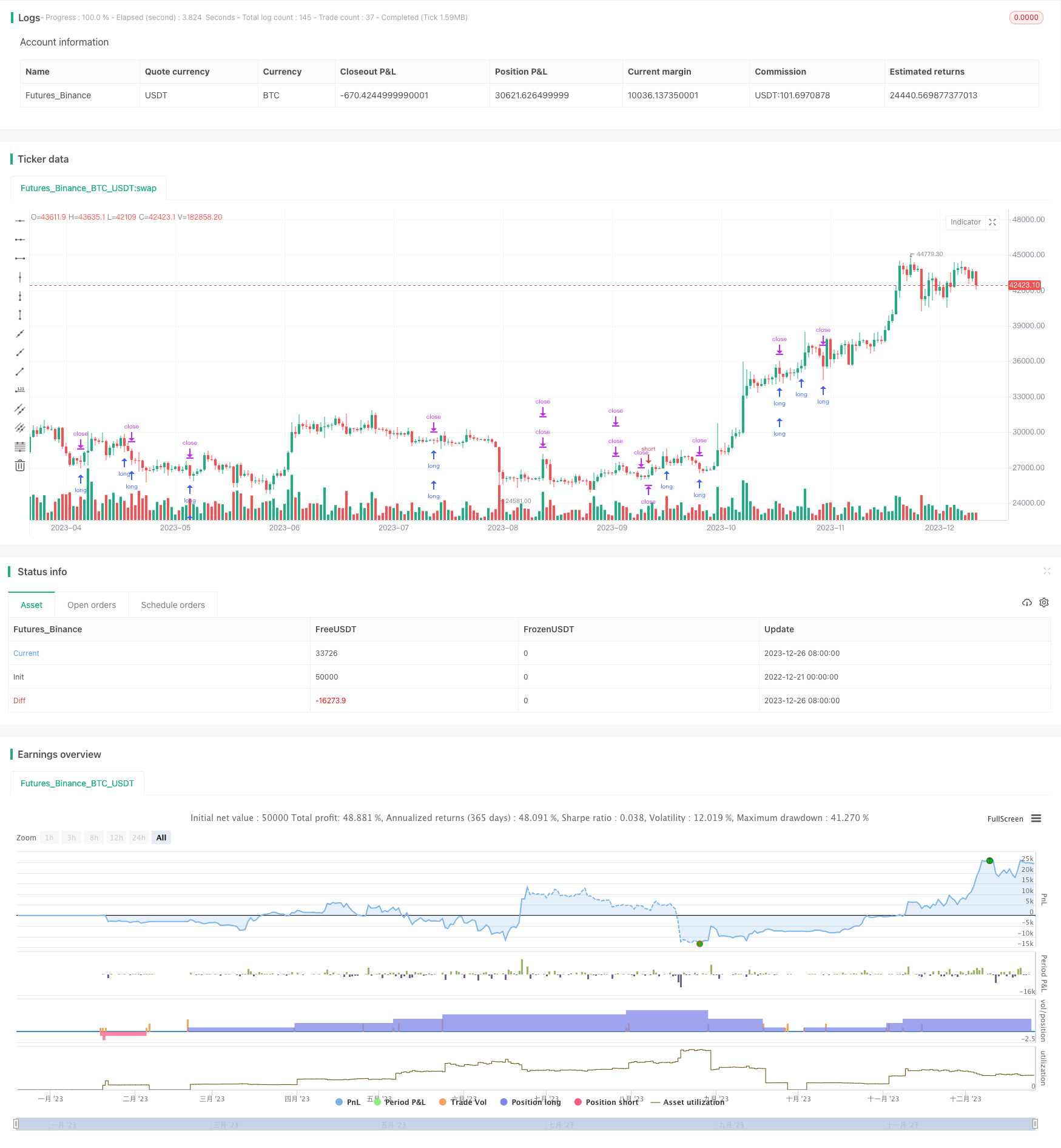
概述
三重EMA叠加突破策略利用三重指数移动平均线指标判断市场趋势方向,在趋势突破点进行入场。该策略同时结合K线形态判断信号优劣。
策略原理
该策略主要基于以下几点原理:
使用三条不同周期的EMA线(200日线、50日线、20日线),判断市场大趋势、中期趋势和短期趋势。
当短期趋势EMA(20日线)向上突破中期EMA(50日线)时产生买入信号;当向下突破时,产生卖出信号。
结合K线形态,判断突破信号的可靠性。只有在第二根K线收盘价高于(低于)前一日的最高价(最低价)时,才认为是可靠的突破。
设置止盈止损点,规避超出合理波动范围的风险。
策略优势
使用多重EMA指标判断趋势,提高判断准确性。
结合K线形态过滤误导信号,避免不必要的交易风险。
设置止盈止损点,有效控制单笔损失。
策略风险
在震荡行情中,EMA指标产生大量误导信号,无法有效判断市场走势。
单一指标组合方式简单,对复杂行情判断力较差。
没有考虑交易成本,在高手续费市场中可能无法盈利。
策略优化
可以引入MACD、KDJ等其他指标,形成指标组合,提高判断准确性。
可以根据不同品种、周期参数进行测试优化,使策略参数更加符合该品种特点。
可以引入交易量指标,避免低量的误导信号。
总结
三重EMA叠加突破策略整体思路清晰易懂,通过EMA判断市场主次趋势,并在趋势发生转折时寻找入场时机。但该策略有一定的局限性,无法很好地处理复杂行情,建议与其他指标组合使用,并进行参数优化,从而适应更广泛的市场环境。
策略源码
/*backtest
start: 2022-12-21 00:00:00
end: 2023-12-27 00:00:00
period: 1d
basePeriod: 1h
exchanges: [{"eid":"Futures_Binance","currency":"BTC_USDT"}]
*/
//@version=5
strategy("GHG RETRACEMENT MODE 1", overlay=true)
entryLevel1 = input(0.5, "ENTRY LEVEL 1")
entryLevel2 = input(0.25, "ENTRY LEVEL 2")
entryLevel3 = input(0.0, "ENTRY LEVEL 3")
stopLevel = input(-0.35, "STOP LEVEL")
tpLevel = input(0.88, "TP LEVEL")
dontUseEma = input(false, "Don't Use EMA")
get_level(level, level100, level0) =>
level * (level100 - level0) + level0
buySignal = close[2] < open[2] and close[1] > open[1] and close[0] > open[0] and high[0] > open[2] and high[1] < high[2]
sellSignal = close[2] > open[2] and close[1] < open[1] and close[0] < open[0] and low[0] < open[2] and low[1] > low[2]
if buySignal and (close[0] > ta.ema(close, 200) or dontUseEma)
l = label.new(bar_index, na)
entryPrice1 = get_level(entryLevel1, high[0], low[2])
entryPrice2 = get_level(entryLevel2, high[0], low[2])
entryPrice3 = get_level(entryLevel3, high[0], low[2])
exitPrice = get_level(tpLevel, high[0], low[2])
stopPrice = get_level(stopLevel, high[0], low[2])
strategy.order("BUY 1", strategy.long, comment="BUY 1", limit=entryPrice1)
strategy.exit("exit", "BUY 1", limit=high[0], stop=stopPrice)
strategy.order("BUY 2", strategy.long, comment="BUY 2", limit=entryPrice2)
strategy.exit("exit", "BUY 2", limit=high[0], stop=stopPrice)
label.set_text(l, "Buy => " + str.tostring(close[2]) + "\nSL=> " + str.tostring(stopPrice) + "\nTP => " + str.tostring(exitPrice) )
label.set_color(l, color.green)
label.set_yloc(l, yloc.belowbar)
label.set_style(l, label.style_label_up)
if sellSignal and (close[0] < ta.ema(close, 200) or dontUseEma)
a = label.new(bar_index, na)
entryPrice1 = get_level(entryLevel1, low[0], high[2])
entryPrice2 = get_level(entryLevel2, low[0], high[2])
entryPrice3 = get_level(entryLevel3, low[0], high[2])
exitPrice = get_level(tpLevel, low[0], high[2])
stopPrice = get_level(stopLevel,low[0], high[2])
strategy.order("SELL 1", strategy.short, comment="SELL 1", limit=entryPrice1)
strategy.exit("exit", "SELL 1", limit=low[0], stop=stopPrice)
strategy.order("SELL 2", strategy.short, comment="SELL 2", limit=entryPrice2)
strategy.exit("exit", "SELL 2", limit=low[0], stop=stopPrice)
label.set_text(a,"Sell => " + str.tostring(close[2]) + "\nSL=> " + str.tostring(stopPrice) + "\nTP => " + str.tostring(exitPrice) )
label.set_color(a, color.red)
label.set_yloc(a, yloc.abovebar)
label.set_style(a, label.style_label_down)